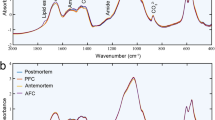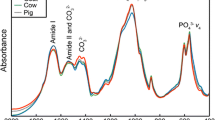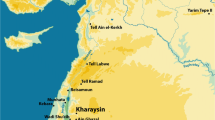Abstract
Identifying the individuals who make up burned and commingled skeletal assemblages represents a labour-intensive challenge. Portable X-ray fluorescence (pXRF) is a potential tool for reconciling fragmented and mixed individuals using the unique elemental content of bone. While the method’s usefulness has been demonstrated with unburned bone, further work is needed to identify if the elemental signatures embedded in bone remain consistent enough, regardless of exposure temperature, to allow the discrimination of burned individuals. We test whether pXRF can discriminate between individuals with variable degrees of burning and further, whether the elemental profiles reliably reflect burning temperatures. Tibiae and femora from five fresh lambs (Ovis aries) were sectioned and experimentally burned for 30 min at 200 °C, 400 °C, 600 °C, 800 °C and 900 °C. Elemental profiles from the unburned and burned fragments were analysed using discriminant function analysis. Whether burned, unburned or variably exposed to heat, fragments from the five individuals were successfully distinguished using aggregate elements (more than 80% of fragments correctly classified). The elemental profiles did vary by degree of burning allowing the distinction of fragments burned at < 200 °C, 400 °C, 600–800 °C and 900 °C (> 90% correctly classified). Collectively, these results show the promise of pXRF in the analysis of burned and commingled assemblages if the elements used are carefully considered and aggregated. However, further work considering diagenetic effects needs to be undertaken.




Similar content being viewed by others
References
Bronner F (2008) Metals in bone: aluminum, boron, cadmium, chromium, lanthanum, lead, silicon, and strontium. In: Bilezikian JP, Raisz LG, Martin TJ (eds) Principles of Bone Biology, 3rd edn. Elsevier, London, pp 515–531
Brooks TR, Bodkin TE, Potts GE, Smullen SA (2006) Elemental analysis of human cremains using ICP-OES to classify legitimate and contaminated cremains. J Forensic Sci 51(5):967–973. https://doi.org/10.1111/j.1556-4029.2006.00209.x
Buddhachat K, Brown JL, Thitaram C, Klinhom S, Nganvongpanit K (2017) Distinguishing real from fake ivory products by elemental analyses: a Bayesian hybrid classification method. Forensic Sci Int 272:142–149. https://doi.org/10.1016/j.forsciint.2017.01.016
Carroll EJ, Squires KE. 2020. Burning by numbers: a pilot study using the quantitative petrography in the analysis of heat-induced alteration in burned bone. International Journal of Osteoarchaeology, 1-9.https://doi.org/10.1002/oa.2902
Castro W, Hoogewerff J, Latkoczy C, Almirall JR (2010) Application of laser ablation (LA-ICP-SF-MS) for the elemental analysis of bone and teeth samples for discrimination purposes. Forensic Sci Int 195:17–27. https://doi.org/10.1016/j.forsciint.2009.10.029
Conrey RM, Goodman-Elgar M, Bettencourt N, Seyfarth A, Van Hoose A, Wolff JA (2014) Calibration of a portable X-ray fluorescence spectrometer in the analysis of archaeological samples using influence coefficients. Geochemistry: Exploration. Environment, Analysis 14:291–301. https://doi.org/10.1144/geochem2013-198
Dermience M, Lognay G, Mathieu F, and Goyens P (2015) Effects of thirty elements on bone metabolism. Journal of Trace Elements in Medicine and Biology, 32:86-106. https://doi.org/10.1016/j.jtemb.2015.06.005
Egeland CP, Pickering TR (2021) Cruel traces: bone surface modifications and their relevance to forensic science. WIREs Forensic Science 3:e1400. https://doi.org/10.1002/wfs2.1400
Ellingham STD, Thompson TJU, Islam M (2016) The effect of soft tissue on temperature estimation from burnt bone using Fourier Infrared spectroscopy. J Forensic Sci 61(1):153–159. https://doi.org/10.1111/1556-4029.12855
Emmitt JJ, McAlister AJ, Phillipps RS, Holdaway SJ (2018) Sourcing without sources: measuring ceramic variability with Pxrf. Journal of Archaeological Science: Reports 17:422–432. https://doi.org/10.1016/j.jasrep.2017.11.024
Etok SE, Valsami-Jones E, Wess TJ, Hiller JC, Maxwell CA, Rogers KD, Manning DAC, White ML, Lopez-Capel E, Collins MJ, Buckley M, Penkman KEH, Woodgate SL (2007) Structural and chemical changes of thermally treated bone apatite. J Mater Sci 42:9807–9816. https://doi.org/10.1007/s10853-007-1993-z
Finlayson JE, Bartelink EJ, Perrone A, Dalton K (2017) Multimethod resolution of a small-scale case of commingling. J Forensic Sci 62(2):493–497. https://doi.org/10.1111/1556-4029.13265
Fleming DEB, Gherase MR (2007) A rapid, high sensitivity technique for measuring arsenic in skin phantoms using portable x-ray tube and detector. Phys Med Biol 52(10):N459–N465. https://doi.org/10.1088/0031-9155/52/19/N04
Forster N, Grave P, Vickery N, Kealhofer L (2011) Non-destructive analysis using PXRF: methodology and application to archaeological ceramics. X-Ray Spectrometry 40:389–398. https://doi.org/10.1002/xrs.1360
Gilpin M, Christensen AM (2015) Elemental analysis of variably contaminated cremains using x-ray fluorescence spectrometry. J Forensic Sci 60(4):974–978. https://doi.org/10.1111/1556-4029.12757
Gonçalves D, Thompson TJU, Cunha E (2011) Implications of the heat-induced changes in bone on the interpretation of funerary behaviour and practice. J Archaeol Sci 38:1308–1313. https://doi.org/10.1016/j.jas.2011.01.006
Gonzalez-Rodriguez J, Fowler G (2013) A study on the discrimination of human skeletons using x-ray fluorescence and chemometric tools in chemical anthropology. Forensic Sci Int 231:407.e1-407.e6. https://doi.org/10.1016/j.forsciint.2013.04.035
Greenwood C, Rogers K, Clement J (2013) Initial observations of dynamically heated bone. Crystal Research and Technology 48(12):1073–1082. https://doi.org/10.1002/crat.201300254
Grupe G, Hummel S (1991) Trace element studies on experimentally cremated bone. I. Alteration of the chemical composition at high temperatures. Journal of Archaeological Science 18:177–186
Harbeck M, Schleuder R, Schneider J, Wiechmann I, Schmahl WW, Grupe G (2011) Research potential and limitations of trace analysis of cremated remains. Forensic Sci Int 2014:191–200. https://doi.org/10.1016/j.forsciint.2010.06.004
Harvig L, Frei K, Price TD, Lynnerup N (2014) Strontium isotope signals in cremated petrous portions as indicator for childhood origin. Plos One 9(7):1–5. https://doi.org/10.1371/journal.pone.0101603
Iriarte E, Carcía-Tojal J, Santana J, Jorge-Villar SE, Teira L, Muñiz J, Ibañez JJ (2020) Geochemical and spectroscopic approach to the characterisation of earliest cremated human bones from the Levant (PPNB of Kharaysin, Jordan). J Archaeol Sci Rep 30:1–13. https://doi.org/10.1016/j.jasrep.2020.102211
Iyengar GV, and Tandon L. 1999. Minor and trace elements in human bones and teeth. International Atomic Energy Agency. Vienna, Austria.
Knüsel CJ, Robb J (2016) Funerary taphonomy: an overview of goals and methods. Journal of Archaeological Science 10:655–673. https://doi.org/10.1016/j.jasrep.2016.05.031
Krap T, Ruijter JM, Nota K, Lieke Burgers A, Aalders MCG, Oostra R-J, Duijst W (2019) Colourimetric analysis of thermally altered bone samples. Scientific Reports 9:8923. https://doi.org/10.1038/s41598-019-45420-8
Lanting JN, Aerts-Bijma AT, van der Plicht. (2001) Dating of cremated bones. Radiocarbon 43(2A):249–254
Little NC, Florey V, Molina I, Owsley DW, and Speakman RJ. 2014. Measuring heavy metal content in bone using portable x-ray fluorescence. In: Tykot RH, editor. Proceedings of the 38th International Symposium on Archaeometry, Tampa, Florida. Open Journal of Archaeometry 2 (5257):19-21. https://doi.org/10.4081/arc.2014.5257
Mamede AP, Gonҫalves D, Marques PM, and Batista de Carvalho LAE. 2017. Burned bones tell their own stories: a review of methodological approaches to assess heat-induced diagenesis. Applied Spectroscopy Reviews:1-33. https://doi.org/10.1080/05704928.2017.1400442
Marsteller SJ, Knudson KJ, Gordon G, Anbar A (2017) Biogeochemical reconstructions of life histories as a method to assess regional interactions: stable oxygen and radiogenic strontium isotopes and Late Intermediate Period mobility on the Central Peruvian Coast. Journal of Archaeological Science: Reports 13:535–546. https://doi.org/10.1016/j.jasrep.2017.04.016
Marques MPM, Gonçalves D, Amarante AIC, Makhoul CI, Parker SF, Batista de Carvalho LAE (2016) Osteometrics in burned human skeletal remains by neutron and optical vibrational spectroscopy. Royal Society of Chemistry 6:68638–68641. https://doi.org/10.1039/c6ra13564a
Marques MPM, Mamede AP, Vassalo AR, Makhoul C, Cunha E, Gonçalves D, Parker SF, Batista de Carvalho LAE (2018) Heat-induced bone diagenesis probed through vibrational spectroscopy. Scientific Reports 8:15935. https://doi.org/10.1038/s41598-018-34376-w
Mayne Correia PM (1997) Fire modification of bone: a review of the literature. In: Haglund WD, Sorg MH (eds) Forensic Taphonomy: The Postmortem Fate of Human Remains. CRC Press, Inc., Boca Raton, Florida, pp 275–93
McKinley JI (1997) Bronze Age ‘barrows’ and funerary rites and rituals of cremation. Proceedings of the Prehistoric Society 63:129–145
Naji S, de Becdeliévre C, Djouad S, Duday H, André A, Rottier S (2014) Recovery methods for cremated commingled remains: analysis and interpretation of small fragments using a bioarchaeological approach. In: Adams BJ, Byrd JE (eds) Commingled Human Remains: Methods in Recovery, Analysis, and Identification. Elsevier Science, Burlington, pp 33–56
Nie H, Sanchez S, Newton K, Grodzins L, Cleveland RO, Weisskopt MG (2011) In vivo quantification of lead in bone with a portable x-ray fluorescence system – methodology and feasibility. Physics in Medicine and Biology 56:N39–N51. https://doi.org/10.1088/0031-9155/56/3/N01
Osterholtz AJ (2019) Advances in documentation of commingled and fragmentary remains. Advances in Archaeological Practice 7(1):77–86. https://doi.org/10.1017/aap.2018.35
Paba R, Thompson TJU, Fanti L, Lugiè C (2021) Rising from the ashes: a multi-technique analytical approach to determine cremation. A case study from Middle Neolithic burial in Sardinia (Italy). Journal of Archaeological Science: Reports 36:1–12. https://doi.org/10.1016/j.jasrep.2021.102855
Perrone A, Finlayson JE, Bartelink EJ, Dalton KD (2014) Application of portable x-ray fluorescence (XRF) for sorting commingled human remains. In: Adams BJ, Byrd JE (eds) Commingled Human Remains: Methods in Recovery, Analysis, and Identification. Elsevier Science, Burlington, pp 145–165
Person A, Bocherens H, Mariotti A, Renard M (1996) Diagenetic evolution and experimental heating of bone phosphate. Palaeogeography, Palaeoclimatology, Palaeoecology 126:135–146
Piga G, Gonҫalves D, Thompson TJU, Brunetti A, Malgosa A, Enzo S (2016) Understanding the crystallinity indices behaviour of burned bones and teeth by ATR-IR and XRD in the presence of bioapatite mixed with other phosphate and carbonate phases. International Journal of Spectroscopy 2016:1–9
Piga G, Solinas G, Thompson TJU, Brunetti A, Malgosa A, Enzo S (2013) Is X-ray diffraction able to distinguish between animal and human bones? Journal of Archaeological Science 40:778–785. https://doi.org/10.1155/2016/4810149
Pemmer B, Roschger A, Wastl A, Hofstaetter JG, Wobrauschek P, Simon R, Thaler HW, Roschger P, Klaushofer K, Streli C (2013) Spatial distribution of trace elements zinc, strontium and lead in human bone tissue. Bone 57:184–193. https://doi.org/10.1016/j.bone.2013.07.038
R Core Team. 2020. R: A language and environment for statistical computing. R Foundation for Statistical Computing, Vienna, Austria. https://www.R-project.org/
Rasmussen KL, Milner G, Skytte L, Lynnerup N, Thomsen JL, Boldsen JL (2019) Mapping diagenesis in archaeological human bones. Heritage Science 7:41. https://doi.org/10.1186/s40494-019-0285-7
Schmahl WW, Kocsis B, Toncala A, Wycisk D, Grupe G (2017) The crystalline state of archaeological bone material. In: Grupe G, McGlynn GC (eds) Across the Alps in Prehistory: Isotopic Mapping of the Brenner Passage by Bioarchaeology. Springer, Cham, Switzerland, pp 75–104
Shackley MS (2011) An introduction to x-ray fluorescence (XRF) analysis in archaeology. In: Shackley MS (ed) X-ray Fluorescence Spectrometry (XRF) in Geoarchaeology. Springer, New York, pp 7–44
Smrčka V (2005) Trace elements in bone tissue. Karolinum Press, Charles University
Snoek C, Lee-Thorp JA, Schulting RJ (2014) From bone to ash: compositional and structural changes in burned modern and archaeological bone. Palaeogeography, Palaeoclimatology, Palaeoecology 416:55–68. https://doi.org/10.1016/j.palaeo.2014.08.002
Snoek C, Lee-Thorp J, Schulting R, de Jong J, Debouge W, Mattielli N (2015) Calcined bone provides a reliable substrate for strontium isotope ratios as shown by an enrichment experiment. Rapid Communications in Mass Spectrometry 29:107–114. https://doi.org/10.1002/rcm.7078
Subira ME, Malgosa A (1993) The effect of cremation on the study of trace elements. International Journal of Osteoarchaeology 3:115–118
Symes SA, Rainwater CW, Chapman EN, Gibson DR, Piper AL (2015) Patterned thermal destruction of human remains in a forensic setting. In: Schmidt CW, Symes SA (eds) The analysis of burned human remains, 2nd edn. Elsevier/Academic, London, pp 17–59
Thompson TJU (2004) Recent advances in the study of burned bone and their implications for forensic anthropology. Forensic Sci Int 146S:S203–S205. https://doi.org/10.1016/j.forsciint.2004.09.063
Thompson TJU (2005) Heat-induced dimensional changes in bone and their consequences for forensic anthropology. Journal of Forensic Science 50(5):1008–1015. https://doi.org/10.1520/JFS2004297
Thompson TJU (2015) The Archaeology of Cremation. Oxbow books, Oxford
Thompson TJU, Islam M, Piduru K, Marcel A (2011) An investigation into the internal and external variables acting on crystallinity index using Fourier transform infrared spectroscopy on unaltered and burned bone. Palaeogeography, Palaeoclimatology, Paleoecology 299:168–174. https://doi.org/10.1016/j.palaeo.2010.10.044
Thompson TJU, Gonçalves D, Squires K, and Ulguim P. 2017. Thermal alteration to the body. In: Schotsmans EMJ, Marquez-Grant N, and Forbes SL, editors. Taphonomy of human remains: forensic analysis of the dead and the depositional environment. Chichester: John Wiley. P.318-334.
Towett EK, Shepherd KD, Lee Drake B (2016) Plant elemental composition and portable X-ray fluorescence (pXRF) spectroscopy: quantification under different analytical parameters. X-Ray Spectrometry 45:117–124. https://doi.org/10.1002/xrs.2678
Trueman CN, Kocsis L, Palmer MR, Dewdney C (2011) Fractionation of rare earth elements within bone mineral: a natural cation exchange system. Palaeogeography, Palaeoclimatology, Paleoecology 310:124–132. https://doi.org/10.1016/j.palaeo.2011.01.002
Wärmländer SKTS, Varul L, Koskinen J, Saage R, Schlager S (2019) Estimating the temperature of heat-exposed bone via machine learning analysis of SCVI colour values: A pilot study. J Forensic Sci 64(1):190–195. https://doi.org/10.1111/1556-4029.13858
Williams H, Cerezo-Román JI, Wessman A (2017) Introduction: Archaeologies of cremation. In: Cerezo-Román JI, Wessman A, Williams H (eds) Cremation and the archaeology of death. Oxford University Press, Oxford, pp 1–24
Winburn AP, Rubin KM, LeGarde CB, Finlayson J (2017) The use of qualitative and quantitative techniques in the resolution of a small-scale medicolegal case of commingled human remains. Florida Scientist 80(1):1–14
Zaichick V, Zaichick S (2016) The effect of age and gender on calcium, phosphorus, and calcium-phosphorus ratio in the crowns of permanent teeth. EC Dental Science 5(2):1030–1046
Zimmerman HA, Meizel-Lambert CJ, Schultz JJ, Sigman ME (2015) Chemical differentiation of osseous, dental, and non-skeletal materials in forensic anthropology using elemental analysis. Science and Justice 55:131–138. https://doi.org/10.1016/j.scijus.2014.11.003
Acknowledgements
The authors also acknowledge the time and encouragement received from the editor and two anonymous reviewers.
Funding
The authors acknowledge the financial support from the School of Social Sciences, University of Auckland.
Author information
Authors and Affiliations
Contributions
Ashley McGarry: conceptualization, methodology, formal analysis and investigation, writing - original draft preparation. Judith Littleton: writing-review and editing, supervision. Bruce Floyd: writing-review and editing, supervision.
Corresponding author
Ethics declarations
Conflict of interest
The authors declare no competing interests.
Additional information
Publisher's note
Springer Nature remains neutral with regard to jurisdictional claims in published maps and institutional affiliations.
Supplementary Information
Below is the link to the electronic supplementary material.
Rights and permissions
About this article
Cite this article
McGarry, A., Floyd, B. & Littleton, J. Using portable X-ray fluorescence (pXRF) spectrometry to discriminate burned skeletal fragments. Archaeol Anthropol Sci 13, 117 (2021). https://doi.org/10.1007/s12520-021-01368-3
Received:
Accepted:
Published:
DOI: https://doi.org/10.1007/s12520-021-01368-3




